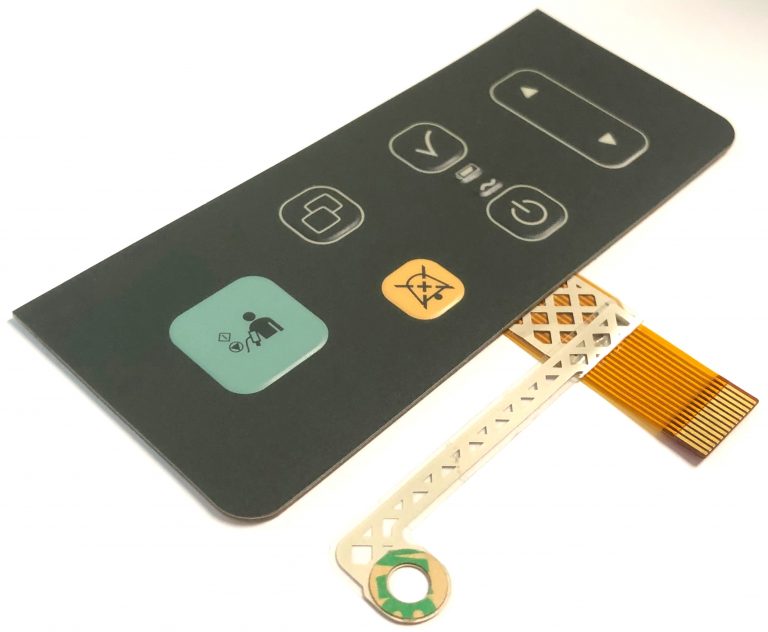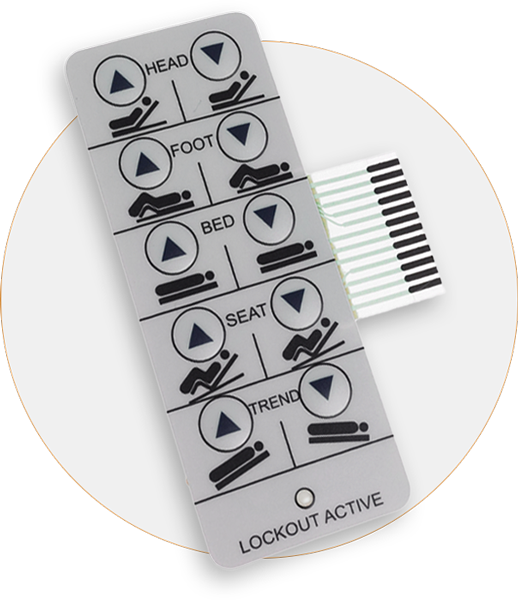If durability matters, sourcing from a trusted membrane switch manufacturer is key.
If durability matters, sourcing from a trusted membrane switch manufacturer is key.
Blog Article
All About Membrane Switch Over: Understanding Its Design and Functionality
When you consider the control interfaces in modern-day devices, membrane layer buttons often come to mind. These parts are a lot more than simply buttons; they blend design and capability flawlessly. Comprehending how they function and what makes them effective can transform your perspective on day-to-day electronics. However, there are subtleties to their layout and efficiency that you could not understand. Allow's explore what sets membrane switches over aside from various other control systems.
What Are Membrane Layer Switches?

Their seamless nature makes them easy to clean and resistant to dust and wetness, a vital attribute in several environments. Membrane switches can likewise be tailored relating to form, dimension, and graphics, allowing manufacturers to develop one-of-a-kind interfaces customized to specific products. Plus, they're lightweight and slim, which aids in minimizing the total mass of gadgets. In general, membrane layer buttons play a substantial role in improving customer experience across a vast range of applications.
How Membrane Switches Job
When you push a secret on a membrane layer switch, it activates a straightforward yet efficient device. The top layer, frequently made from flexible product, presses down onto a conductive layer below it. This action bridges the gap between conductive traces, completing an electrical circuit. As quickly as the circuit shuts, it sends out a signal to the tool's controller, which interprets your input.
You'll see that the responsive feedback varies based on the button layout, supplying either a soft click or a more obvious action. When you release the key, the membrane layer go back to its initial position, reopening the circuit and quiting the signal. This process occurs virtually immediately, guaranteeing a receptive individual experience.
Membrane layer buttons are popular as a result of their toughness and resistance to dirt and wetness, making them ideal for numerous applications, from household home appliances to clinical gadgets. Understanding this operation aids you appreciate their widespread usage.
Key Components of Membrane Layer Switches
Recognizing the crucial components of membrane switches is fundamental for grasping their performance and design. At the core, you'll locate the graphic overlay, which provides the visual interface for users. Beneath that, there's a spacer layer that separates the circuit layers, making certain that they don't make get in touch with up until pushed. The circuit layer is where the magic takes place; it consists of conductive traces that finish the circuit when you press the switch. One more vital aspect is the sticky support, enabling the switch to adhere to surface areas safely. Ultimately, the safety layer shields versus environmental elements and put on, prolonging the button's life expectancy. Each component plays a substantial duty in guaranteeing dependable performance and user communication. By comprehending these parts, you'll gain understanding into how membrane layer switches operate and their importance in numerous applications.
Materials Used in Membrane Layer Switch Over Style
The efficiency and durability of membrane switches greatly depend on the products used in their style. You normally come across polyester and polycarbonate as key substrates because of their outstanding strength and versatility. These products withstand scrapes and chemicals, making them ideal for demanding atmospheres.
The you can check here conductive layers usually utilize silver or carbon, picked for their integrity and conductivity. membrane switch manufacturer. Silver gives superior performance, while carbon is an affordable option. For the overlay, you could think about a matte or shiny surface, depending on your visual requirements and individual experience
Make particular to choose adhesives that stand up to ecological variables like temperature and moisture. Selecting the appropriate products will certainly guarantee your membrane layer switch stands the test of time.
Style Considerations for Membrane Switches
While creating membrane layer buttons, it's crucial to think about different elements that affect their capability and individual experience. Begin by focusing on the format and button dimension; make sure they're user-friendly and easy to navigate. Take into consideration the tactile comments you wish to offer-- will customers need a noticeable click or a softer touch? In addition, consider the materials you'll utilize, as they'll affect longevity and appearances.
Validate your design fits ecological elements, like wetness or temperature level variants, which might influence efficiency. By carefully taking into consideration these aspects, you'll produce a membrane layer button that boosts use and contentment.
Applications of Membrane Layer Buttons
Membrane layer switches are versatile components located in numerous applications, from commercial devices to consumer electronics. You'll see their impact in equipments that call for durable interfaces and in gadgets that take advantage of smooth styles. Recognizing these applications helps you appreciate the functionality and practicality of membrane layer buttons in day-to-day innovation.
Industrial Tools Usage
When you're wanting to boost the capability of commercial tools, membrane switches provide a reliable option that integrates longevity with straightforward style. These switches are best for harsh environments, supplying resistance to dirt, wetness, and chemicals. You'll find them in control panels for making equipments, HVAC systems, and clinical tools, where precision and responsiveness are essential. Their low account implies they fit flawlessly into different equipment, saving important space while preserving convenience of use. With adjustable graphics and backlighting alternatives, you can develop an intuitive interface for operators, boosting effectiveness and safety and security. And also, their lengthy lifespan minimizes upkeep prices, making them a clever financial investment for your commercial applications. Welcome membrane layer switches to enhance your operations and boost overall performance.
Customer Electronic Devices Integration
In the domain name of consumer electronics, membrane buttons play an essential role in boosting individual communication and gadget capability. You'll discover them in gadgets like microwaves, push-button controls, and video gaming consoles, providing a seamless way to communicate with click reference innovation. Their sleek layout enables very easy assimilation into various items, making controls instinctive and easy to use. With their ability to incorporate graphics and backlighting, you can appreciate a modern-day visual that complements the gadget's total appearance. Membrane layer buttons also ensure resilience and resistance to dust and dampness, expanding the lifespan of your electronics. By picking membrane layer buttons, you boost not simply the performance yet additionally the style of your devices, making everyday interactions smooth and pleasurable.
Benefits and Drawbacks of Membrane Layer Buttons
While membrane layer switches supply an array of benefits, they also come with some downsides that you need to Your Domain Name take into consideration. One significant advantage is their portable design, making them perfect for space-constrained applications.

However, there are negative aspects. Membrane layer buttons can have a shorter life-span compared to mechanical buttons, specifically under hefty use. They can additionally be much less tactile, which could influence user feedback throughout procedure. Moreover, if harmed, fixing them can be difficult and frequently calls for complete substitute. Inevitably, their level of sensitivity to extreme temperature levels and environmental conditions might restrict their efficiency in certain setups. Stabilizing these pros and disadvantages will certainly assist you determine if membrane buttons are the best fit for your task.
Often Asked Inquiries
How Much Time Do Membrane Switches Usually Last?
Membrane switches over generally last in between 5 to one decade, depending on use and ecological conditions. You'll wish to assess aspects like wear, exposure to wetness, and temperature fluctuations to determine their durability properly.
Can Membrane Layer Switches Be Customized for Details Designs?
Yes, you can tailor membrane buttons to fit certain layouts (membrane switch manufacturer). You'll have the flexibility to pick colors, forms, and designs that match your project's requirements, ensuring they mix flawlessly with your overall visual
What Is the Expense Variety for Membrane Switch Over Manufacturing?
The price variety for membrane layer switch manufacturing typically drops between $1 and $10 per system, relying on elements like design complexity, amount, and materials. You can obtain quotes from suppliers to discover the very best choice.

Are Membrane Layer Switches Over Water Resistant or Resistant?
Membrane buttons can be created to be water resistant or resistant, depending upon products made use of and building and construction methods. If you need them for wet environments, guarantee you specify those requirements throughout the layout procedure.
Just How Do Membrane Changes Compare to Conventional Switches?
Membrane buttons are usually thinner and extra versatile than standard switches, using a smooth layout. They're commonly easier to clean up and integrate, yet could not give the responsive feedback you're made use of to with mechanical choices.
Final thought

Report this page